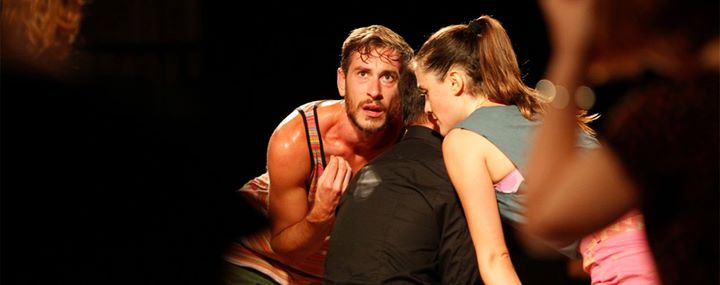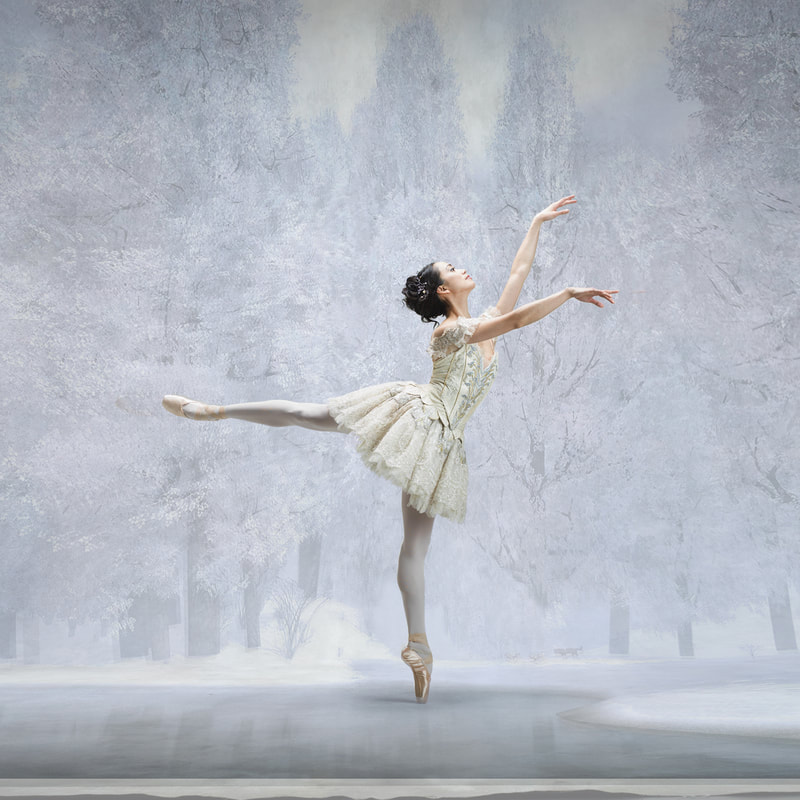In a lightless room, the senses are heightened. That shutting down of sight especially perks the ears. And that’s how an audience sat on Saturday night at MassMoCA’s showing of “Listening to Walls Wear Off Their Color.”
This haunting work-in-progress, created in just a few days at sprawling museum for contemporary art, was a byproduct of the vivid imaginations of director Maya Zbib, choreographer Lee Serle (both of whom performed) and conceptual artist Mateo Lopez. The piece, though still in its earliest stages, transported viewers to an alternative realm where time is not linear and one’s mind is a flashpoint of memories, mostly of loss of home and loved ones, and readjusting in unknown land. It was an ode to refuges, uprooted and sent to an unfamiliar city where they were isolated, literally boxed in by their language, their look and their culture. But it was also about the universal need to love, to seek out and touch fellow humans. “Listening to Walls” began in total darkness with the sound of a synthetically created hum. The audience sat like that for what seems like an eternity, until we heard a voice. It was Zbib. She said “the city awakens.” Then in a quiet, controlled, but strong tone, she spilled out shards of a life’s moments: the home’s rattled windows from explosions, the sewing kit in one’s bag, the recipes you wrote for your son and sleeping in the bottom deck of a ship. Together, it created a sense of a woman who is forced to leave and seek a safe haven. When the lights finally rise, we see three figures (Serle and dancers Simon Courchel and Jin Ju Song-Begin) and three upright box structures. Serle hangs out of his, either sleeping or dead. The other two are standing inside these coffin like builds – Song-Begin facing outward, but Courchel half-hidden. To a limpid electronic soundscape designed by John Torres and Zbib’s guiding voice, the dancers come to life and effortlessly wheel their boxes about their world silently. They walk their structures, combining and reconfiguring them again and again to create rooms and outdoor spaces in which the dancers appeared either to be vulnerable or shielded. Throughout Zbib spoke of the woman, lost in a foreign city and in love with a stranger. In episodic clips, she told of her search for him, his adverted eyes and her sense of his closeness. The intimacy was striking. Toward the end, the three were together, holding hands inside one of their arranged box clusters. But their proximity ended with Serle flat on the floor again and Song-Begin arched lifeless atop of him. Courchel walked away from it all. But as he left, he hesitated and turned back to the heartbreaking carnage of xenophobic loneliness.
0 Comments
Stella Abrera danced the "Nutcracker" grand pas de deux with Alexandre Hammoudi at Kaatsbaan's 28th annual gala. Kaatsbaan International Dance Center’s galas are unlike any other fancy fundraising events for dance. The directors don’t get bogged down in motifs, premieres or novelties. They strive for the best.
And because the best unwinds like a spool of gold in such an intimate setting, the center’s 120-seat auditorium, audiences are struck by the power of the art not the price of ornamentation. That’s what happened on Saturday night. The center’s 28th annual “A Passion for Dance” featured New York Theatre Ballet in Jerome Robbins’ Grecian “Antique Epigraphs” with the peerless composer Joan Tower with Michael Scales at the piano playing the four-hands Debussy’s score. The evening also showcased the company in a pas de deux from “Such Longings” by Richard Alston as well as the “Nutracracker” grand pas de deux with American Ballet Theatre principals Stella Abrera and Alexandre Hammoudi. Legendary ballerina Martine Van Hamel performed an all-too short solo “On Performing.” Martha Graham Dance Company star Blakeley White-McGuire shattered the night with excerpts from “Cave of the Heart.” And that was followed by a knock-out world premiere choreographed by New York City Ballet principal Lauren Lovette. It was a fantastic night. There is hardly a squabble with anything that was done – except for maybe the lighting in “Antique Epigraphs,” which usually casts a sepia-toned shimmer on the dancers. Staged by Kyra Nichols, the eight female dancers, dressed in muted colored tunics, enthralled with Robbins’ stylized configurations that came to rest in elegant poses. They looked as if an urn has spun, pitching its bas relief figures to life. Needless to say, the music with Tower, Scales and flutist Mira Magrill was gorgeous. Equally beautiful and moving was Steven Melendez and Amanda Treiber in “Such Longings” to Chopin’s Mazurka Op 17 No 4 and his Nocturne Op 27 No 2. Melendez, the lead male in many New York Theatre Ballet programs, has matured into a soulful dancer that brings much to the stage. The rapport with Treiber too, whom he has been partnered with for years, shows a richness and depth that often goes missing when two dancers meet. Abrera and Hammoudi also share chemistry and daring in the grand pas de deux in the holiday favorite from Tchaikovsky. Choreographed by ABT’s Alexei Ratmansky, the pas savored the usual Sugarplum Fairy and her Cavalier’s elegance with a dash of sport. While a tad under rehearsed, Hammoudi missed his mark a few times, their sauciness kept everyone in the seats smiling. Even more delightful was Lovette’s premiere of “Le Jeune” for five couples from ABT Studio Company. To Eric Whitacre’s “Equus,” the dancers flew through a frolicsome and frothy gambol that announced that Lovette is not only is a wonderful dancer, she’s also an amazing dance maker. The ballet had a retro-Balanchine look with the female dancer in leotards encircled with a belt. But it was fully-fledged contemporary creation that signaled the end of a drought for female choreographers coming out of City Ballet. The Van Hamel short, conceived by Ann Marie De Angelo, was an ode to the joys of performing. While the prima ballerina can probably no longer whip of 32 fouettes without pain, she has not lost her glamorous sparkle. Finally, White-McGuire held audiences in a vice as Medea in Graham’s “Cave of the Heart.” Her grip on the role, its intentions and its murderous ending was unflinching. It also reminded how modern Graham’s work remains. No one, except those in the know, could date it to 1946. White-McGuire lent it a vitality that could speak to everyone today. Bravo all! |
Wendy
|


 RSS Feed
RSS Feed
